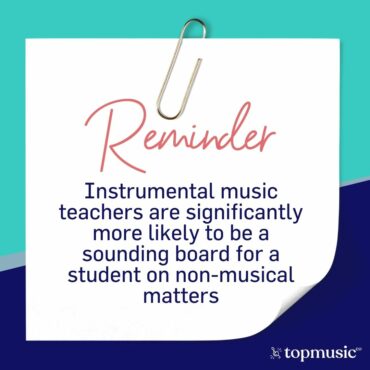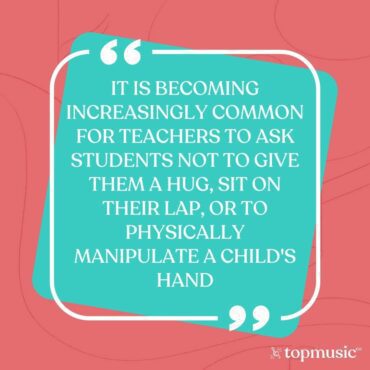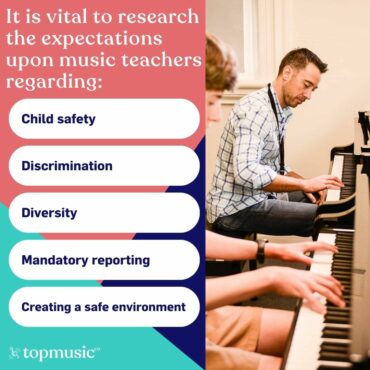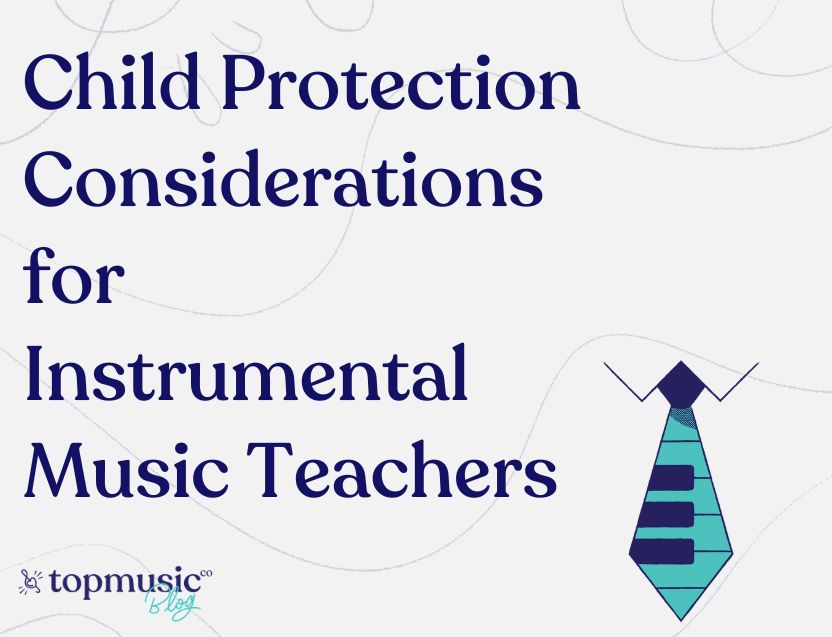Child protection is important in all areas of life.
It’s vital that you’re aware of the legal and ethical implications of protecting the vulnerable people you come in contact with as an instrumental music teacher.
Child protection is important in all areas of life.
It’s vital that you’re aware of the legal and ethical implications of protecting the vulnerable people you come in contact with as an instrumental music teacher.
Table Of Contents
Instrumental music teachers are unique.
There are not many other non-family adults in a child’s life who are allowed to have regular (often weekly) one-on-one contact with students.
We get to know our students well and often become safe people to them.
This is great for building rapport, tailoring an education to them, and so on. But we are also significantly more likely to be a sounding board for a student on non-musical matters too.
Sadly, some students in our world may be victims of abuse. Knowing what to do if a student discloses abuse is a serious matter.
Understandably, most teachers are distressed by this concept. No matter our own discomfort as individuals, as professionals we must choose not to avoid the topic but to educate ourselves. We have responsibilities as authority figures in the lives of the children we teach.
The author of the Hippocratic oath is attributed to saying, “to do good or to do no harm.” It is appalling to think of anyone intentionally harming a child, but it is negligent for us to dismiss this topic in favor of feeling less uncomfortable.
For the same of the well-being of the children that we teach, it is beneficial to consider not only “to do good” but also “to do no harm.”
Some instrumental teachers have not researched the implications of this topic and may be unaware of the expectations upon them regarding:
Before continuing, it must be stated that there is undoubtedly legislation that applies in your state or country.
It is beyond the scope of this article to present legal requirements across multiple jurisdictions, so teachers need to understand and follow the law specific to where they live.
With this in mind, it is important to consider what principles are common to all of us – not just in upholding the law but also in honoring the humans we encounter.
It would be prudent for all instrumental teachers to undertake training in this area even if their locality doesn’t require it by law.

In Australia, child protection comes under the umbrella of caring for Vulnerable Individuals.
‘Vulnerable individuals’ are defined as people under the age of 18, or those who may be unable to take care of themselves, or unable to protect themselves against harm or exploitation. This could be due – but not limited to- their age, an illness, trauma, disability, or some other form of disadvantage.
Australian Goverment, “EXTERNAL CONDUCT STANDARD 4: PROTECTION OF VULNERABLE INDIVIDUALS”
No ruler knuckle-rapping is likely to be taking place in our generation, but many of us experienced teachers bullying or coercing us into participation at swimming carnivals or taunting us when we took twice as long as others to finish the cross-country.
Is that harm?
Each teacher should find out the definition of harm according to their government.
An example from Australia is as follows:
Indicidents of harm may include:
Australian Goverment, “GOVERNANCE TOOLKIT: SAFEGUARDING VULNERABLE PEOPLE”
- Sexual harassment, bulling, or abuse
- Serious sexual offenses, such as rape
- Threats of violence or actual violence
- Verbal, emotional or social abuse
- Cultural or identify abuse, such as racial, sexual, or gender0based discrimination or hate crimes
- Coercion and exploitation
- Abuse of power
Professional Development or a training course that covers this topic is likely to define each of these and give scenarios for a teacher to consider. A course will also cover the particulars around police checks in your state.
Understanding the principles behind these concepts will help teachers make wise decisions. Even conduct that is not illegal may still not be the best choice.
The government of the Australian Capital Territory outlines this point well in its Code of Conduct for Teachers, School Leaders and Principals:
Remember, ethical behaviour is not just a matter of following the letter of the law or sticking to the obligations of the Code of Conduct. Teachers should also act within the spirit of the law and the Code of Conduct. It is not sufficient to think that your behaviour is ethicial, it must also be seen to be so. The appearance of unethical behaviour can be just as damanging to public confidence in the profession as unethical conduct itself.
Australian Capital Territory Govement “Code of Conduct: Teachers, School Leaders, and Principals”
It is becoming increasingly common for teachers to ask students not to give them a hug or sit on their lap. It is also becoming less common for teachers to physically manipulate a child’s hand with their own hand during an instrumental lesson. Teachers are recommended to think carefully to determine what to do in their own studio.
The Music Teachers National Association in the USA has a document available to members called “A Brief Legal Guide for the Independent Music Teacher.”
This features the answers to more than sixty questions surrounding the issues of protecting vulnerable students and yourself.

There are now very few professions where adults and children are allowed to work in a room together one-on-one without supervision.
The principle behind this practice is that it is unwise to be in a position where an accusation could be made against you regarding an event in which you had no witnesses.
The expectation is not that there is a criminal lurking behind every unguarded moment. In contrast, this transparency across the board will diminish risk and create a safer environment for vulnerable people and for the people who care for them.
For those students who have a parent attending instrumental lessons with them, supervision is straightforward.
If parents are not attending, you have some considerations to make.
If you teach in a school environment, the leadership will presumably require you to undergo regular training and to understand the school policies that exist regarding child protection.
If you are teaching from your home or commercial premises, you will need to consider how to make a safe, visible space for one-on-one lessons.
School classroom doors have windows that need to be uncovered. This is both so first responders can assess danger in the case of fire or another emergency and to provide accountable supervision opportunities.
Instrumental studios without windows to any waiting area may need to make adjustments or leave the door open.
Teachers protecting themselves with video camera recordings have been more popular in the last few decades, but this leads to further ethical concerns around obtaining consent for taking photos of children in your studio.
Again, finding out the law and then making wise boundaries for your studio is key.
Logically, it is sensible to have a phone close at hand to call for help in case of any threat, whether fire, electrical fault, medical emergency, or whatever may arise. Whether legislated in your area or not, training in first aid and CPR is highly recommended, as is knowing what to do in the case of an anaphylactic episode.
Perish the thought, but there have been cases of adult students or parents of students having a moment of potential violence, sexual harassment, or similar.
Knowing your procedure in such a situation is important: quickly dialing an emergency contact is a great option when you need it.
Teachers need not think they need to keep everything to themselves. Discuss any uncomfortable situations with a trusted ally as soon as you can to prevent further occurrences.
Research the laws on mandatory reporting in your state or area.
Some adults are required by law to report certain behaviors and utterances.
Mandatory reporting requirements include instructions about:
Even if you are not a mandated reporter, you may need support if you notice significant changes in a student like frequent bruising or rapid weight loss, for example.
When family structures change for your students, it is important to uphold impartiality. This can be a challenge if you only know one of the parents involved. Be wary of an invitation to provide written support of either parent.
In a school setting, families are asked to inform all relevant authority figures if there are changes to who has permission to collect a child from school and who to contact first in the case of an emergency. You may wish to add a line to your studio policy regarding custody arrangements or powers of attorney.
In the case of significant estrangement, confidentiality is vital. If there is a restraining order in place, for example, an estranged partner should not be able to ascertain information about a child’s location, contact number, school, etc. A parent may wish to rescind a photo release form in this case.

While it would be convenient to have a link with all the answers for each of our teachers all around the world, it is simply not possible.
Whether you need to take child protection training, whether you are a mandatory reporter, or whether you need a police check – requirements can differ from state to state, let alone country to country! You need to know what the law is in your area.
You can also be proactive in educating yourself about wise practices. Contact a government provider of child protection training and ask how to proceed from here. A local helpline for reporting child endangerment may be able to point you in the right direction, as would your region’s music teacher association. Having these bases covered before you encounter a challenge is the best approach.
Australia: Child Protection Agencies
USA: State Child Abuse and Neglect Reporting Numbers
UK: National Society for the Prevention of Cruelty to Children
Dwelling on devastating issues like abuse and harm is far removed from traditional TopMusic content. While it is a confronting topic to talk about, child protection is more important than ever in today’s world.
Our mission is to nurture and develop the pedagogical and business skills of teachers so that they can inspire the next generation of musicians to enjoy a lifelong love of music.
The next generation of musicians is vulnerable by definition because of their age and stage of life, so we do not shy away from our responsibilities to the whole person and to their families.
This article features in the TopMusic Certification program. To learn more about being a TopMusic Certified teacher, click here.
